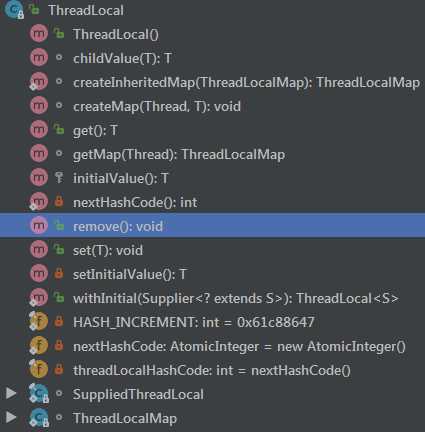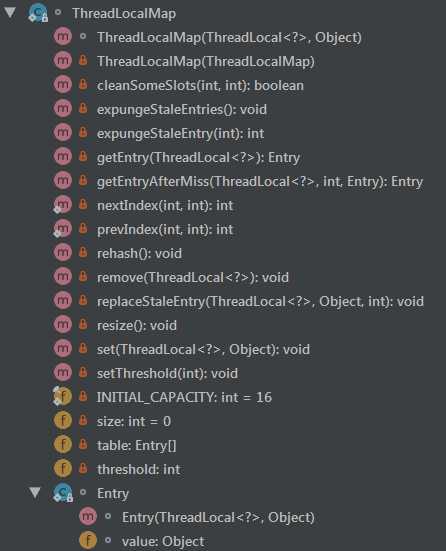标签:strong hold not after adl enc 变量 table 通过
一 类结构


主要是set(T), get(), remove()方法

二 TheadLocal是什么时候创建的
threadLocal的初始化, lazy creating, 用到的时候(get 或者 set)再初始化

void createMap(Thread t, T firstValue) {
t.threadLocals = new ThreadLocalMap(this, firstValue);// this 指代的是theadlocal
}
private T setInitialValue() {
T value = initialValue();
Thread t = Thread.currentThread();
ThreadLocalMap map = getMap(t);
if (map != null)
map.set(this, value);
else
createMap(t, value);
return value;
}
public T get() {
Thread t = Thread.currentThread();
ThreadLocalMap map = getMap(t);
if (map != null) {
ThreadLocalMap.Entry e = map.getEntry(this);
if (e != null) {
@SuppressWarnings("unchecked")
T result = (T)e.value;
return result;
}
}
return setInitialValue();
}
public void set(T value) {
Thread t = Thread.currentThread();
ThreadLocalMap map = getMap(t);
if (map != null)
map.set(this, value);
else
createMap(t, value);
}
三 TheadLocal 是如何保存的
ThreadLocalMap(ThreadLocal<?> firstKey, Object firstValue) {
table = new Entry[INITIAL_CAPACITY];
int i = firstKey.threadLocalHashCode & (INITIAL_CAPACITY - 1);
table[i] = new Entry(firstKey, firstValue);
size = 1;
setThreshold(INITIAL_CAPACITY);
}
初始化时,threadlocal作为第一个key,
由ThreadLocal中的 createMap方法和set方法 new ThreadLocalMap(this, firstValue) 结合
public void set(T value) {
Thread t = Thread.currentThread();
ThreadLocalMap map = getMap(t);
if (map != null)
map.set(this, value);
else
createMap(t, value);
}
private void set(ThreadLocal<?> key, Object value) {
// We don‘t use a fast path as with get() because it is at
// least as common to use set() to create new entries as
// it is to replace existing ones, in which case, a fast
// path would fail more often than not.
Entry[] tab = table;
int len = tab.length;
int i = key.threadLocalHashCode & (len-1);
for (Entry e = tab[i];
e != null;
e = tab[i = nextIndex(i, len)]) {
ThreadLocal<?> k = e.get();//threadLocal的实际引用地址。
if (k == key) {
e.value = value; //第N次set,将线程变量值实际存入Entry,ThreadLocalMap中维护由Entry组成的数组
return;
}
if (k == null) {
replaceStaleEntry(key, value, i);//第一次set
return;
}
}
tab[i] = new Entry(key, value);
int sz = ++size;
if (!cleanSomeSlots(i, sz) && sz >= threshold)
rehash();
}
上文的代码解读:由于Entry继承自WeakReference,所以e.get()指代的是TheadLocal的实际引用地址。
static class Entry extends WeakReference<ThreadLocal<?>> {
/** The value associated with this ThreadLocal. */
Object value;
Entry(ThreadLocal<?> k, Object v) {
super(k);
value = v;
}
}
以上代码就是变量值是如何存入的,下面来看怎么取出线程变量值
public T get() {
Thread t = Thread.currentThread();
ThreadLocalMap map = getMap(t);
if (map != null) {
ThreadLocalMap.Entry e = map.getEntry(this);
if (e != null) {
@SuppressWarnings("unchecked")
T result = (T)e.value;
return result;
}
}
return setInitialValue();
}
private Entry getEntry(ThreadLocal<?> key) {
int i = key.threadLocalHashCode & (table.length - 1);
Entry e = table[i];
if (e != null && e.get() == key)
return e;
else
return getEntryAfterMiss(key, i, e);
}
总结,线程变量threadLocal是通过自定义实现的hash存于TheadLocalMap中的Entry数组的。
四 TheadLocal是如何销毁的
public void remove() {
ThreadLocalMap m = getMap(Thread.currentThread());
if (m != null)
m.remove(this);
}
结束语
为什么要用WeakReference, 当threadlocal最后一次被get后, 就不会再有引用指向threadlocal了,从而ThreadLocalMap中的Entry所存的变量值就可以被GC回收了。
在使用完线程变量后, 一定要及时清理,remove,尤其是在使用线程池的情况下。否则会造成内存溢出。
标签:strong hold not after adl enc 变量 table 通过
原文地址:https://www.cnblogs.com/shoubianxingchen/p/11031616.html